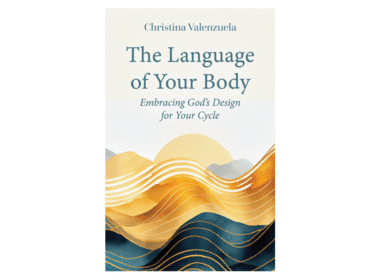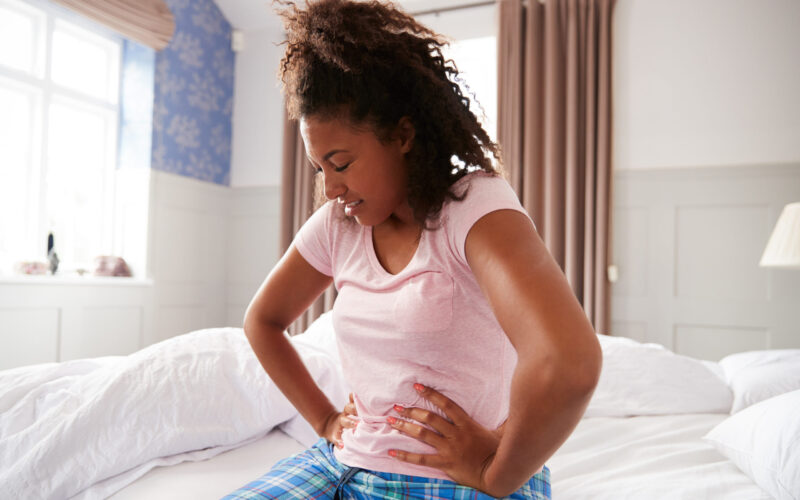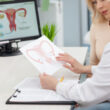Mittelschmerz is German for “middle pain,” the telltale ovulation pain or cramping that signals that your body is in ovulation mode.
Mittelschmerz happens in an estimated twenty percent of women [1], and is often felt on one side of the lower abdomen (although pain on both sides is also possible). Mittelschmerz can happen before ovulation, just as ovulation occurs, or right after ovulation.
What does mittelschmerz feel like?
Mittelschmerz pain can vary from woman to woman, and even from cycle to cycle. For some women, mittelschmerz feels dull and aching. Some women may even experience mild cramping, akin to light menstrual cramps. Others may feel a sharp, sudden pain. Sometimes mid-cycle cramping may even be accompanied by spotting.
What causes ovulation pain or cramping?
The exact cause of mittelschmerz is unknown. One theory is that the pain comes from the swelling of a mature follicle pressing against the wall of one of your ovaries as it tries to break through and release an egg. Another theory is that blood and fluid released during the bursting of the follicle causes irritation in the abdominal cavity. Another theory is that the actual bursting of the egg from out of the follicle may cause a sharp, sudden pain. Finally, it is thought that the spasming of the fallopian tubes or uterus as the body aids movement of the egg after ovulation may cause some cramping or discomfort.
While some may find mittelschmerz annoying, to me, it’s a good thing to recognize! Good, because ovulation is a good thing—it is a sign of health, and I want to know that I am healthy. Don’t you?
Healthy ovulation pain vs. bad ovulation pain: When to go to your doctor
Of course, pain is generally not thought of being good for us. In fact, it’s often a sign that something is wrong. But in the case of ovulation, I’m not so sure that’s true.
Perhaps we can think of normal ovulation pain in terms of “healthy pain,” similar to the pain we feel when we exercise. After all, when our muscles work hard, sometimes there is pain—and it’s not always a bad thing! Similarly, when a woman’s uterus is contracting as she prepares to give birth, the pain she feels is precisely because her body is doing what it is supposed to do. Of course, people who exercise regularly know the difference between the “good burn” you feel during a great workout and the feeling of injury, and women who have given birth before know what normal contractions should feel like. That is where trusting that you know your body best—and trusting your instincts—can be an important part of figuring out when something is wrong, and advocating for yourself in the doctors’ office.
Normal mittelschmerz pain is generally not severe, debilitating, or disruptive of your life and activities—and it is never accompanied by a fever. It is also short-lived, usually lasting for less than a day. If you experience severe mid-cycle pain (especially pain so severe as to cause nausea, or make sex incredibly uncomfortable or even painful), it may be a sign of another issue, such as endometriosis or ovarian cysts. If your mid-cycle pain is this severe or disruptive, or if your pain persists or is accompanied by other symptoms like fever, it is likely not healthy ovulation pain, and you should definitely talk to your doctor about it.
Using birth control for mittelschmerz
Unfortunately, women who go to mainstream doctors complaining of pain that occurs every month may be prescribed birth control to suppress ovulation. While this may prevent mid-cycle discomfort, it will also interrupt the process of ovulation. But given that ovulation is a normal, healthy thing for a woman to experience, arguably even an essential part of what makes her a woman, is suppressing it really the right thing to do? Equally troubling is that birth control may mask the symptoms of an underlying disorder (like endometriosis or polycystic ovary syndrome), making it harder to detect or diagnose the disorder, and to get real, restorative treatment for it. Finally, it must be said that hormonal birth control can affect your body in other negative ways, too.
How to determine whether your mittelschmerz is normal, or the symptom of an underlying disorder
If you’re experiencing mid-cycle pain or cramping, it’s important to determine that the pain is actually due to the egg-releasing process, and not a symptom of a disorder. To do so, you need to figure out the timing of the pain and to see if there is a pattern. This is an example of where an understanding of your own unique menstrual cycle is invaluable to your health!
For example, like most women, you likely do not ovulate at the same time every month. You may have longer cycles or shorter cycles, and you may not ovulate on the textbook 14th day of your cycle. However, what is likely pretty consistent is the length of your luteal phase—that is, the number of days between when you ovulate and when your next period begins—which is between 12 and 16 days long for a woman with a healthy cycle. Knowing this information can help you figure out when you should expect ovulation pain to occur (no guesswork involved!) and when your next period will begin.
Tracking ovulation pain
Every time you experience mid-cycle pain, you should put a symbol on your calendar indicating when the pain occurred and on what side. If you want to be the best expert on YOUR BODY, do what one client of mine does and put abbreviations like “RAP” or “LAP” for right ab pain or left ab pain. Or make up your own appropriate symbols based on where the pain occurred, ie. low back, etc.
After charting your discomfort, mark when your period starts and stops. Then, after a few months, you’ll be able to see if there is a relationship between your body’s efforts to ovulate and your discomfort. Some women who have never paid much attention to their cycles before may actually find that their discomfort is not ovulatory but premenstrual.
Charting your cycle gives you the most information
Of course if you’re charting with a formal method of fertility awareness, you are trained to recognize exactly the timing of your ovulation, and you will have no problem connecting the pain/cramps and your ovulation. You can put a marker on your chart, whether it’s a phone app or a paper chart.
You can also know if it’s something else if the pain or cramps are persistent, but do not clearly coincide with the ovulation process. In this case, you can take your chart to your doctor for their consideration. A pelvic exam may reveal disorders such as endometriosis or abnormal cysts; in these cases the pain is clearly not a sign of a healthy process, and there are treatments that get to the root cause of these issues.
(But you may never know the cause if you don’t learn to chart your cycles!)
What natural treatments help with mittelschmerz pain?
Okay, so let’s say you’ve documented your suspected mittelschmerz pain for a few months. You know it is always roughly the same distance from the start of your period, and you want to find methods to treat ovulation pain in a way that doesn’t suppress ovulation.
More good news. Pain, especially temporary pain, is easy to manage with salicyclates (aspirin) or acetaminophen (which is preferable to ibuprofen, because ibuprofen can interfere with the prostaglandins that bring about ovulation). Or, if you’re like me, you’d rather take a hot bath, which increase blood flow and gets your body to relax. A hot bath can be especially beneficial if you use some Epsom salts, which allows the muscle–relaxing effect of magnesium sulfate to be directly absorbed through the skin, thus bypassing any gut issues it could cause. Other mittelschmerz pain management options include using a heating pad, or one of those microwaveable hot-cold bags filled with beans, either of which would help increase blood flow (and lessen pain). Gentle yoga with deep breathing into the abdominal cavity, or massage that is specifically designed for your reproductive organs can also work. Essential oils that promote relaxation and tension may also be helpful, chamomile and lavender being some calming options. Add a few drops to your bath, hot compress, or massage oil.
Again, keep in mind that it is a natural process causing this mid-cycle pain, and it is useful for informing you of when you are at peak fertility. Go with it. Be kinder to yourself during this time. Take it easy. Maybe make yourself a ginger turmeric tea (see recipe below), which always helps me feel less achy after a good workout—I find that the anti-inflammatory properties of the ginger and turmeric [2] work just as well on ovulation aches.
The take-home message is that with mittelschmerz, you’ve identified something that shows you can ovulate—which is not something to take for granted—and it will pass! Yes, it may come back next month, but that’s not entirely a bad thing, especially if you share it with partner and discuss implications in terms of upcoming PMS-ish symptoms and, of course, the potential for baby making (or avoiding).
Remember that when it comes to any pain during your cycle, documenting when it occurs will tell you what exactly you are dealing with—which is truly an empowering thing!
Pain-Mellowing Yellow Tea
½ teaspoon turmeric powder (find it in the spice aisle, no need to go to a health food store)
1 tablespoon goat’s milk powder, or ½ cup of the milk that agrees with you most
½ cup of hot water (if using goat’s milk powder)
a pinch of ground ginger (which can also be found in your grocer’s spice aisle)
Put everything in your favorite mug, stir, inhale the steamy goodness…and enjoy, maybe in a hot bath!
References:
[1] Durai R, Ng P. Mittelschmerz mimicking appendicitis. Br J Hosp Med. 2009;70(7):419-419. doi:10.12968/hmed.2009.70.7.43133
[2] Kuptniratsaikul V, Dajpratham P, Taechaarpornkul W et al. Efficacy and safety of Curcuma domestica extracts compared with ibuprofen in patients with knee osteoarthritis: a multicenter study. Clin Interv Aging. 2014:451. doi:10.2147/cia.s58535
When this article refers to fertility awareness methods (FAM), or natural family planning (NFP), we are referring to Fertility Awareness-Based Methods, evidence-based methods of cycle charting which can be used as effective forms of natural birth control when learned by a certified instructor.
This article was originally published on August 22, 2015 as written by Emily Kennedy. It has since been updated by Natural Womanhood to offer more resources. Last updated November 6, 2020.
Additional Reading:
Spotting between your periods could be a sign of endometriosis
Painful sex before your period? How tracking your cycle could help stop sex from hurting
Reasons Women Need Periods: The Role of the Menstrual Cycle in the Immune System
Five Ways to Naturally Induce Ovulation and Regulate Your Cycle











